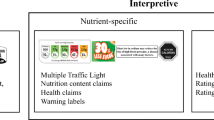Abstract
As a means of enhancing consumer understanding of nutritional information, the Nutrition Labeling and Education Act of 1990 requires the provision of percentage daily values (%DVs) on food labels. Findings from existing research, however, vary in their support for the assumption that including %DVs will assist consumers in their efforts to comprehend nutritional information. To shed further light on this issue, the present study examines the moderating role of consumer knowledge about how to use %DVs in evaluating a product’s healthiness. The results indicate that the usefulness of providing %DVs on a nutritional label depends strongly on this form of knowledge. Implications for public policy and directions for future research efforts are presented.
Similar content being viewed by others
References
Alba, Joseph W. and J. Wesley Hutchinson. 1987. “Dimensions of Consumer Expertise.”Journal of Consumer Research 13 (March): 411–454.
Axelson, Marta L. and David Brinberg. 1992. “The Measurement and Conceptualization of Nutrition Knowledge.”Journal of Nutrition Education 24 (5): 239–246.
Barone, Michael J., Randall L. Rose, Kenneth C. Manning, and Paul W. Miniard. 1996. “Another Look at the Impact of Reference Information on Consumer Impressions of Nutrition Information.”Journal of Public Policy and Marketing 15 (1): 55–62.
Brucks, Merrie, Andrew A. Mitchell, and Richard Staelin. 1984. “The Effect of Nutritional Information Disclosure in Advertising: An Information Processing Approach.”Journal of Public Policy and Marketing 3: 1–25.
Burton, Scot and J. Craig Andrews. 1996. “Age, Product Nutrition, and Label Format Effects on Consumer Perceptions and Product Evaluations.”Journal of Consumer Affairs 30 (1): 68–89.
— and Abhijit Biswas. 1993. “Preliminary Assessment of Changes in Labels Required by the Nutrition Labeling and Education.”Journal of Consumer Affairs 27 (1): 127–144.
——, and Richard Netemeyer. 1994. “Effects of Alternative Nutrition Label Formats and Nutrition Reference Information on Consumer Perceptions, Comprehension, and Product Evaluations.”Journal of Public Policy and Marketing 13 (Spring): 36–47.
Celsi, Richard L. and Jerry C. Olson. 1988. “The Role of Involvement in Attention and Comprehension Processes.”Journal of Consumer Research 15 (September): 210–224.
Cole, Catherine A. and Gary J. Gaeth. 1990. “Cognitive and Age-Related Differences in the Ability to Use Nutritional Information in a Complex Environment.”Journal of Marketing Research 37 (May): 175–184.
Federal Register. 1990. “Food Labeling: Mandatory Status of Nutrition Labeling and Nutrient Content Revision.” 55 (139): 29487–29533.
—. 1993. “Food Labeling Regulations Implementing the Nutrition Labeling and Education Act of 1990.” 58 (3): 2066–2090.
Jaccard, James. 1998.Interaction Effects in Factorial Analysis of Variance. Thousand Oaks, CA: Sage.
Levy, Alan S., Sara B. Fein, and Raymond E. Schucker. 1991. “Nutrition Labeling Formats: Performance and Preference.”Food Technology 45 (July): 116–121.
——, and —. 1996. “Performance Characteristics of Seven Nutrition Label Formats.”Journal of Public Policy and Marketing 15 (1): 1–15.
Moorman, Christine. 1990. “The Effects of Stimulus and Consumer Characteristics on the Utilization of Nutrition Information.”Journal of Consumer Research 17 (December): 362–374.
—. 1996. “Information Processing Activities: The Case of the Nutrition Labeling and Education Act.”Journal of Public Policy and Marketing 15 (1): 28–44.
Petty, Richard E. and John T. Cacioppo. 1986. “The Elaboration Likelihood Model of Persuasion.” InAdvances in Experimental Social Psychology, Vol. 19. Eds. Leonard Berkowitz. New York: Academic Press, 123–205.
Russo, J. Edward, Richard Staelin, Catherine A. Nolan, Gary J. Russell, and Barbara L. Metcalf. 1986. “Nutrition Information in the Supermarket.”Journal of Consumer Research 13 (June): 48–70.
Suter, Tracy A. and Scot Burton. 1996. “An Examination of Correlates and Effects Associated With a Concise Measure of Consumers’ Nutrition Knowledge.”Family and Consumer Sciences Research Journal 25 (2): 117–136.
Viswanathan, Madhubalan. 1994. “The Influence of Summary Information on the Use of Nutrition Information.”Journal of Public Policy and Marketing 13 (Spring): 48–60.
Wyse, Bonita, Ann W. Sorenson, Arthur J. Wittwer, and R. Gaurth Hansen. 1976. “Nutritional Quality Index Identifies Consumer Nutrient Needs.”Food Technology 30 (January): 20–40.
Author information
Authors and Affiliations
Additional information
Fuan Li (Ph.D., Florida International University) is an assistant professor of marketing in the Walker School of Business at Mercyhurst College (Erie, Pennsylvania). He has been a faculty member at East China Normal University (Shanghai, China) and St. Olaf College (Northfield, Minnesota). His current research interests include consumer choice, consumer responses to trust advertising appeals, and relationship marketing. His work has been published both in English and in Chinese.
Paul W. Miniard (Ph.D., University of Florida) is the BMI professor of marketing and the Ph.D. program director in the College of Business Administration at Florida International University (Miami, Florida). His research focuses on consumer behavior and advertising and has been published in a number of business and psychology journals. He is also a coauthor of a consumer behavior textbook.
Michael J. Barone (Ph.D., University of South Carolina) is an associate professor of marketing in the College of Business Administration at Iowa State University (Ames, Iowa). His research, which primarily involves consumer responses to advertising and consumer choice, has been published in theJournal of Marketing Research, Journal of Consumer Psychology, Marketing Letters, Journal of the Academy of Marketing Science, Journal of Advertising, Journal of Advertising Research, Journal of Business Research, andJournal of Public Policy & Marketing, as well as in various conference proceedings.
Rights and permissions
About this article
Cite this article
Li, F., Miniard, P.W. & Barone, M.J. The facilitating influence of consumer knowledge on the effectiveness of daily value reference information. JAMS 28, 425–436 (2000). https://doi.org/10.1177/0092070300283009
Issue Date:
DOI: https://doi.org/10.1177/0092070300283009




